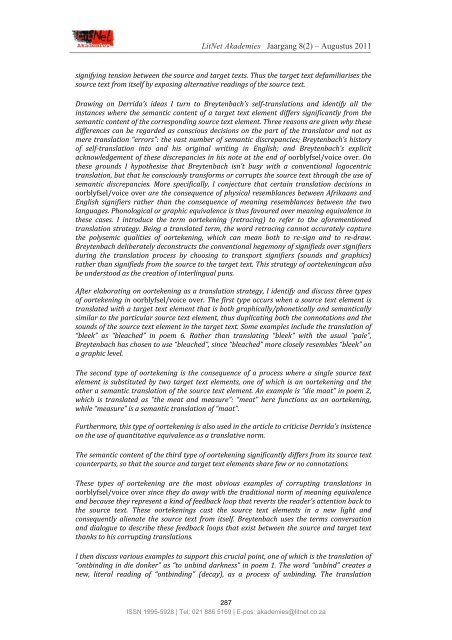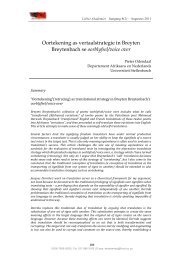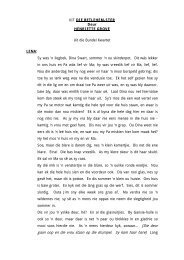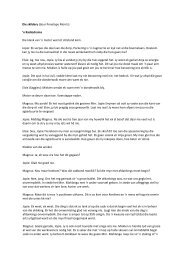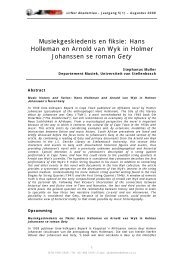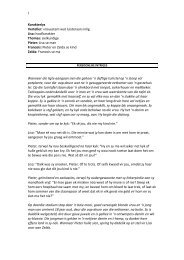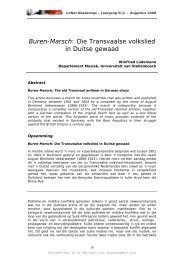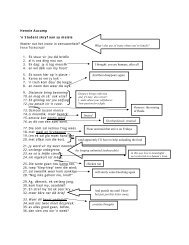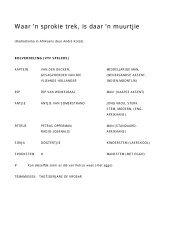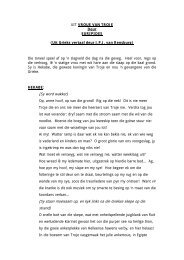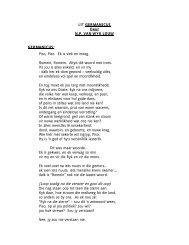Jaargang 8, nommer 2 – Augustus 2011 - LitNet
Jaargang 8, nommer 2 – Augustus 2011 - LitNet
Jaargang 8, nommer 2 – Augustus 2011 - LitNet
You also want an ePaper? Increase the reach of your titles
YUMPU automatically turns print PDFs into web optimized ePapers that Google loves.
<strong>LitNet</strong> Akademies <strong>Jaargang</strong> 8(2) <strong>–</strong> <strong>Augustus</strong> <strong>2011</strong><br />
signifying tension between the source and target texts. Thus the target text defamiliarises the<br />
source text from itself by exposing alternative readings of the source text.<br />
Drawing on Derrida’s ideas I turn to Breytenbach’s selftranslations and identify all the<br />
instances where the semantic content of a target text element differs significantly from the<br />
semantic content of the corresponding source text element. Three reasons are given why these<br />
differences can be regarded as conscious decisions on the part of the translator and not as<br />
mere translation “errors”: the vast number of semantic discrepancies; Breytenbach’s history<br />
of selftranslation into and his original writing in English; and Breytenbach’s explicit<br />
acknowledgement of these discrepancies in his note at the end of oorblyfsel/voice over. On<br />
these grounds I hypothesise that Breytenbach isn’t busy with a conventional logocentric<br />
translation, but that he consciously transforms or corrupts the source text through the use of<br />
semantic discrepancies. More specifically, I conjecture that certain translation decisions in<br />
oorblyfsel/voice over are the consequence of physical resemblances between Afrikaans and<br />
English signifiers rather than the consequence of meaning resemblances between the two<br />
languages. Phonological or graphic equivalence is thus favoured over meaning equivalence in<br />
these cases. I introduce the term oortekening (retracing) to refer to the aforementioned<br />
translation strategy. Being a translated term, the word retracing cannot accurately capture<br />
the polysemic qualities of oortekening, which can mean both to resign and to redraw.<br />
Breytenbach deliberately deconstructs the conventional hegemony of signifieds over signifiers<br />
during the translation process by choosing to transport signifiers (sounds and graphics)<br />
rather than signifieds from the source to the target text. This strategy of oortekeningcan also<br />
be understood as the creation of interlingual puns.<br />
After elaborating on oortekening as a translation strategy, I identify and discuss three types<br />
of oortekening in oorblyfsel/voice over. The first type occurs when a source text element is<br />
translated with a target text element that is both graphically/phonetically and semantically<br />
similar to the particular source text element, thus duplicating both the connotations and the<br />
sounds of the source text element in the target text. Some examples include the translation of<br />
“bleek” as “bleached” in poem 6. Rather than translating “bleek” with the usual “pale”,<br />
Breytenbach has chosen to use “bleached”, since “bleached” more closely resembles “bleek” on<br />
a graphic level.<br />
The second type of oortekening is the consequence of a process where a single source text<br />
element is substituted by two target text elements, one of which is an oortekening and the<br />
other a semantic translation of the source text element. An example is “die maat” in poem 2,<br />
which is translated as “the meat and measure”: “meat” here functions as an oortekening,<br />
while “measure” is a semantic translation of “maat”.<br />
Furthermore, this type of oortekening is also used in the article to criticise Derrida’s insistence<br />
on the use of quantitative equivalence as a translative norm.<br />
The semantic content of the third type of oortekening significantly differs from its source text<br />
counterparts, so that the source and target text elements share few or no connotations.<br />
These types of oortekening are the most obvious examples of corrupting translations in<br />
oorblyfsel/voice over since they do away with the traditional norm of meaning equivalence<br />
and because they represent a kind of feedback loop that reverts the reader’s attention back to<br />
the source text. These oortekenings cast the source text elements in a new light and<br />
consequently alienate the source text from itself. Breytenbach uses the terms conversation<br />
and dialogue to describe these feedback loops that exist between the source and target text<br />
thanks to his corrupting translations.<br />
I then discuss various examples to support this crucial point, one of which is the translation of<br />
“ontbinding in die donker” as “to unbind darkness” in poem 1. The word “unbind” creates a<br />
new, literal reading of “ontbinding” (decay), as a process of unbinding. The translation<br />
287<br />
ISSN 1995-5928 | Tel: 021 886 5169 | E-pos: akademies@litnet.co.za


